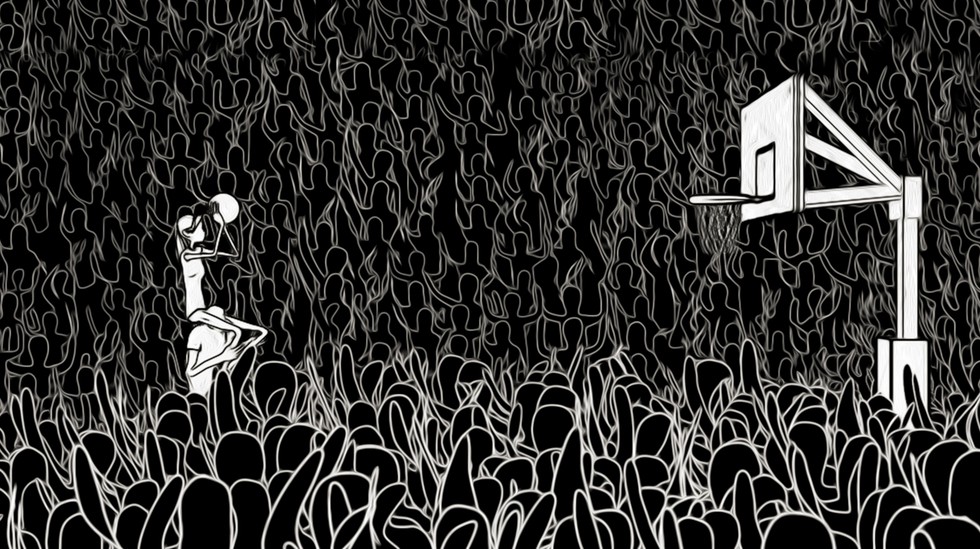Melissa Johnson is a writer and filmmaker living in Venice, California. She is best known for her award-winning feature documentary, No Look Pass, about a Burmese lesbian basketball star, currently airing on Showtime. No Look Pass was recently selected to participate in the highly celebrated 2014 American Film Showcase, sponsored by the U.S. State Department and the University of Southern California. Johnson has written popular first-person essays for The New York Times, Salon.com and the Boston Herald, including the inspiration for “Love in the Time of March Madness,” which smashed traffic records for Salon.com. (The story presented in this animated short film is true, based on Johnson’s real-life misadventures.)
She is currently making a documentary about 6'8" basketball phenomenon Brittney Griner playing her first season as a professional in China. Her previous experience includes co-producing a 30 for 30 film for ESPN alongside John Singleton (Boyz n the Hood) about track superstar Marion Jones. As Senior Producer for Comedy Central and BBC America, Johnson ran websites for hit television shows including The Colbert Report and Top Gear. She also co-created an original web series called The Worst Speeches of All Time that premiered on ComedyCentral.com in August 2009 and has garnered a million views to date. (Press materials)
The 9-minute “Love in the Time of March Madness” will debut at the Tribeca Film Festival on April 19.
Please give us your description of the film playing.
Melissa Johnson hit 6'4" tall in 8th grade. Although this made her an instant basketball star, “Love in the Time of March Madness” explores her hilarious and awkward true-life misadventures in romance as she dates shorter men and gets cheered or jeered wherever she goes. This animated short film is told in a striking black & white “through the looking-glass” aesthetic with exaggerated perspectives and a distinctly handmade feel. Blazing with honesty and dark humor, this story about embracing difference is certain to disarm and delight.
What drew you to this story?
I made “Love in the Time of March Madness” because it’s in my bones, literally. It’s a dark comedy about my dating life as a woman who hit 6'4" tall in 8th grade at 127 pounds with size 12 feet — and lived to tell about it.
Wherever I go, I receive endless commentary from strangers about my height and unsolicited opinions about the appropriate height of my man, whether I am standing with a guy at the moment or not. There’s an assumed familiarity with me — the emotional equivalent of a pregnant woman who gets her tummy rubbed wherever she goes. Only I’ve been “getting rubbed” for about twenty years. “Remember, people are always going to be looking at you,” my mother told me as a kid. “So what are you going to do with that?” I started keeping a notebook in my bag, jotting down my favorite encounters.
The experience is sometimes painful, other times flattering, often hilarious, and always revealing about the conditions we place upon one another about gender roles and physicality. I’m so grateful for my unusual vantage point through life and made “Love in the Time of March Madness” in hopes of helping others embrace their bodies as well. After all, we don’t see other people the way that they are, we see them the way that we are. We are canvases for each another.
What was the biggest challenge?
The complexity and scope of the animation presented in “LTMM” was a beastly amount of work for a tiny, self-funded team. My partner in making the film, Director of Animation Robertino Zambrano, and I decided to refuse to sacrifice our standards, so it took three years to complete nine minutes.
What advice do you have for other female directors?
Tattoo the word “Onward!” on the inside of your eyelids.
What’s the biggest misconception about you and your work?
That documentaries or true-life stories are easier to create than fiction. “They just sorta ‘tell themselves,’ right?” Like you wake up one morning and there they are, hanging in your closet all stitched and starched, ready to go.
Do you have any thoughts on what are the biggest challenges and/or opportunities for the future with the changing distribution mechanisms for films?
There have never been more opportunities for distribution, which is fantastic — but alongside that comes the massive responsibility of the independent filmmaker to build his or her audience from the ground up. It’s not enough to make a fabulous film — you must embrace the challenge of getting your film seen by audiences even after you sell it. You’re one part Art, one part Business. Don’t wait for you or your film to be “discovered” — that’s a myth. Get your hands on the gears.
Name your favorite women directed film and why.
I was fourteen years old when A League of Their Own came out. It made a profound impact on me as a budding athlete and filmmaker. Penny Marshall, wherever you are — I love you.






